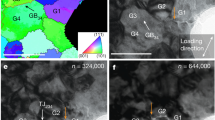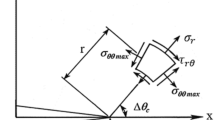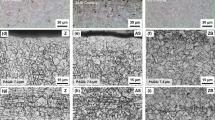Abstract
FIG. 1 shows the fracture surfaces of an alloy steel specimen of 0.5 in. × 1 in. section which had been fatigued by bending in a cantilever machine1 at the Royal Aircraft Establishment, stressing being of the form 1.1 σ ± σ. Cracking started from a 60° V notch 1/8 in. deep and having a root radius of 0.002 in. which was machined in the specimen. Measurements of the fatigue crack propagation rate were made using an electrical resistance method to measure the crack length2. The light areas on the fracture surface are regions where the crack was advancing at a rate of about 10−6−10−5 in. cycle−1, while the dark areas are regions in which the crack advanced by brittle cracking at a much faster rate, the rapid advance being accompanied by a cracking noise from the specimen. After its rapid advance the crack resumed its normal rate of about 10−5 in. cycle−1. This type of failure is always obtained for this type of steel fatigued at room temperature. It was first thought that the brittle fracture advance occurred during one stress cycle, the crack then resuming its original rate. If this was the case, however, it is difficult to see why the crack, having acquired a high velocity, should stop before the specimen was completely broken.
This is a preview of subscription content, access via your institution
Access options
Subscribe to this journal
Receive 51 print issues and online access
$199.00 per year
only $3.90 per issue
Buy this article
- Purchase on Springer Link
- Instant access to full article PDF
Prices may be subject to local taxes which are calculated during checkout
Similar content being viewed by others
References
Pearson, S., Royal Aircraft Establishment Tech. Rep. No. 66204 (1966).
Gilbey, D. M., and Pearson, S., Royal Aircraft Establishment Tech. Rep. No. 66402 (1966).
Author information
Authors and Affiliations
Rights and permissions
About this article
Cite this article
PEARSON, S. Fast Cracking during Fatigue Crack Propagation in Metals. Nature 219, 150–151 (1968). https://doi.org/10.1038/219150a0
Received:
Published:
Issue Date:
DOI: https://doi.org/10.1038/219150a0
Comments
By submitting a comment you agree to abide by our Terms and Community Guidelines. If you find something abusive or that does not comply with our terms or guidelines please flag it as inappropriate.



